The iPhone 7 and iPhone 7 Plus Review: Iterating on a Flagship
by Joshua Ho & Brandon Chester on October 10, 2016 8:00 AM EST- Posted in
- Smartphones
- Apple
- Mobile
- iOS
- iOS 10
- iPhone 7
- iPhone 7 Plus
GPU Performance
Section by Brandon Chester
Now that the general system and CPU performance of A10 Fusion has been characterized, we can move on to more focused benchmarks for the GPU and the storage subsystem. Apple's keynote for the iPhone 7 actually disclosed that the GPU in A10 Fusion is a six core part. The last time I recall Apple mentioning specifics about their GPU was with the launch of the iPad 3, where the GPU was advertised as a quad core implementation that turned out to be SGX543MP4.
The use of a six core GPU is interesting because there's not much choice for Apple given that A9 also used the six core PowerVR GT7600. It really boils down to three possibilities. The first is that Apple has actually continued using the exact same GT7600 microarchitecture as on the A9, albeit with an improved layout on the die. The second is that Apple has moved to PowerVR GT7600 Plus, which brings some improvements to integer compute performance, and memory bandwidth optimizations. And the third is the wildcard option - that Apple has put to use its significant GPU engineering resources on a more customized design; something that's still using the PowerVR architecture, but more custom than ever before. This is a longer discussion to have in our full deep dive, but Ryan's of the opinion that this is somewhere between options two and three, that Apple has done some significant work to produce a highly optimized version of the PowerVR GT7600 Plus
In any case, as Apple isn't using a radically different GPU architecture, most of Apple's stated 50% increase in GPU power comes from increasing the clock speeds, with optimizations such as memory and caching picking up the rest. This is interesting because Apple also advertises that A10 Fusion's GPU uses only two thirds the power of A9, which would indicate a lot of work done by Apple to optimize for power usage.


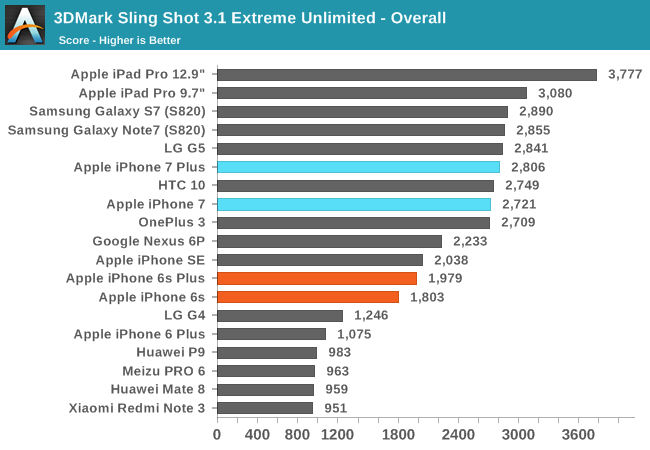
3DMark Sling Shot is broken down into a few different tests, and at the end the results of graphics tests and physics tests produce separate scores which are then used to generate an overall score.
In the graphics test the results are in line with Apple's stated GPU performance improvement of 50%. The physics score, which is really a CPU test, only improves by 30-35%, which has a direct correlation to the increase in peak clock speed from 1.8GHz on A9 to 2.3GHz in A10 fusion.
Like Ice Storm, the physics test is still basically a chart of devices ranked by cores multiplied by max frequency, and you can see that the iPhones have improved very little over the years, with the improvements tracking closely to Apple's increases in CPU clock speed. This comes down to the test being designed in such a way that there's little instruction level parallelism to exploit due to memory dependencies, which puts Apple's wide dual core CPU at a disadvantage. While it is certainly a valid test situation, it's not really reflective of actual 3D game performance because you would generally not write a game in such a way that it cannot exploit the performance of its target hardware.
Even with the smaller improvement in the physics tests, the overall score for the iPhone 7 is still roughly 50% higher than the Apple A9 devices like the iPhone 6s and SE.
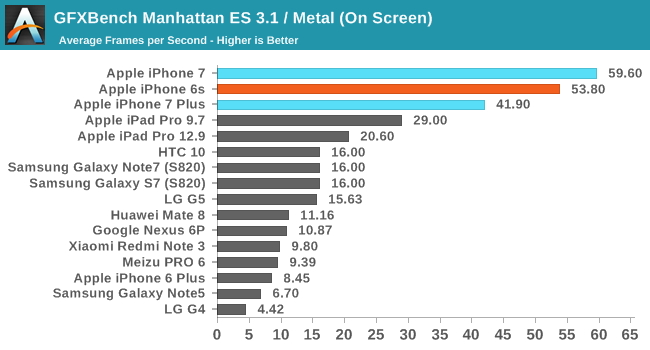
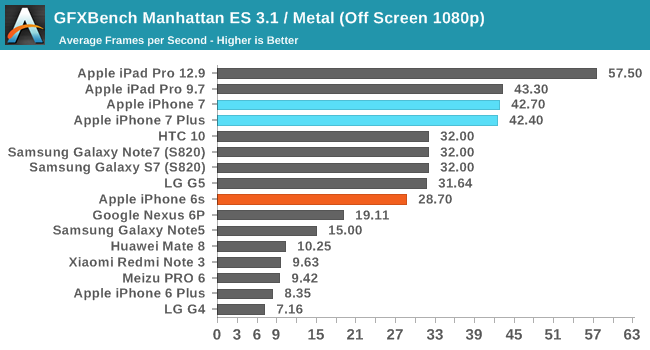
We originally migrated away from Manhattan ES 3.0 to Manhattan ES 3.1 / Metal to push back on devices hitting VSync in the on screen tests. Unfortunately it didn't work for long. With the iPhone 7's increase in GPU performance not being accompanied by an increase in display resolution, the on screen result in GFXBench Manhattan is higher than any other device, and is essentially at the display's refresh limit. The iPhone 7 Plus isn't able to hit Vsync due to its higher resolution, but the on screen result of roughly 42fps is nothing to scoff at either considering the visual complexity of the test.
While on screen performance is helpful from the perspective of someone who wants to see how the phone will actually perform when running a game at its native resolution, to compare directly between devices you need to standardize the rendering resolution. As its name implies, GFXBench's off screen test simply renders all the frames at 1080p in an off screen buffer. In this test the iPhone 7 and 7 Plus both run slightly below 43fps, which puts them right where you'd expect from Apple's claim of 50% greater GPU performance. In GFXBench this also puts the two of them at the same level as the 9.7" iPad Pro for absolute GPU performance.
This gives some interesting insight into the relative clock speeds that Apple is running their GPUs at, as A9X uses a twelve core PowerVR Series7XT GPU, while A10 Fusion uses only six. As I mentioned before, the performance improvements in A10 Fusion primarily come from increasing the peak clock speed. Matching the 9.7" iPad Pro's A9X suggests that Apple has targeted a fairly aggressive clock speed for the GPU in A10 Fusion, and while we can't verify Apple's claim of A10's GPU running at only two thirds the power of A9, if that is indeed the case it would represent a great deal of optimization effort on Apple's part to achieve that despite increasing clock speeds this significantly.
Storage Performance
One of the big changes that came with Apple's A9 and A9X SoCs was a new storage controller designed internally at Apple. This was not the first Apple product to use an in-house SSD controller, as the 2015 MacBook used a PCIe SSD and adopted the NVMe interface. A9 and A9X adapted this for use in mobile, and the sequentual performance in particular was far ahead of anything in a competing mobile device.
Apple hasn't advertised any improvements to storage performance with A10 Fusion, but it's worth running tests to verify that performance has remained at the same level. There are also potential gains in write performance when increasing the total capacity of an SSD by adding additional dies. At this point there's really no benchmark that can give comperable results between iOS and Android, so I've decided against doing a cross-platform comparison here.
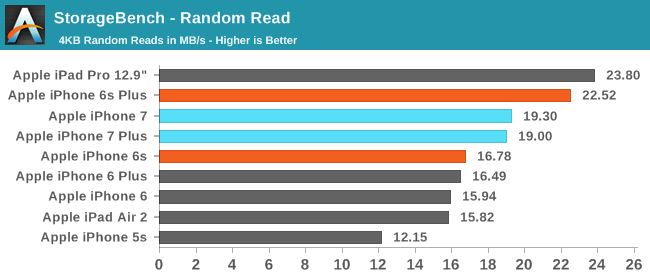
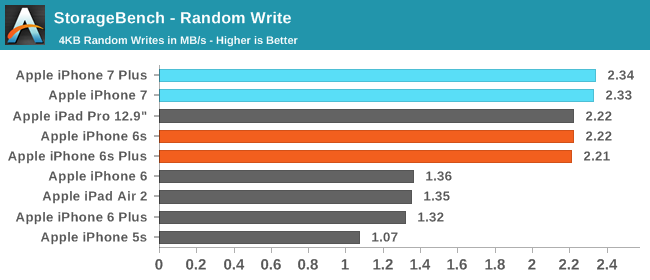

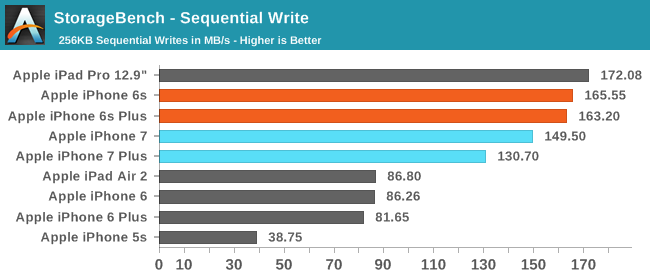
In general, the NAND performance of the iPhone 7 and 7 Plus is equivalent to the iPhone 6s and 6s Plus. There are some minor differences, but essentially all of them can be attributed to testing variance. The only thing that is worth noting is that there's no significant improvement to write performance even though the iPhone 7 units tested are 256GB models while the 6s and 6s Plus were 128GB models. This suggests that the NAND packages use higher capacity dies so there's no additional parallelism to take advantage of.










377 Comments
View All Comments
Daniel Egger - Sunday, October 16, 2016 - link
Amen to that.techconc - Monday, October 10, 2016 - link
Blind tests are interesting, but not necessarily accurate. For example, if you take 13,000 random people off of the internet and show them pictures, it shouldn't be very surprising that the majority of them will prefer over saturated and inaccurate images. For the untrained eye, these are often more aesthetically pleasing. However, for real photographers that actually care about things like color accuracy, they are a joke. It also shouldn't be surprising that a much smaller percentage of the random population is able to accurately assess a photo. That's not to suggest that I think the iPhone wins in every photo. Rather, I don't take these random polls very seriously and treat them for what they are.cknobman - Monday, October 10, 2016 - link
techconc and grayson you are both correct and if you read the article it does mention the exact points you bring up. People tend to prefer over saturation and colors that pop.Its a very similar reason why TV manufacturers set the default settings so high and why people are drawn to TV's on the showroom floor.
All the same, most people are not professionals, and most professionals do not use a smartphone as their main camera.
techconc - Monday, October 10, 2016 - link
Fair enough... I'm just trying to understand the point you were trying to make with the blind photo test. If it's to point out that most people viewing such surveys don't know what they're looking at, then I agree with you. However, from the tone of your post, you seemed to be using this as the basis for claiming how much better the S7 was.On a side note, you mention the headphone jack. I think we can all agree this is a minor inconvenience for some in the short term, but I wouldn't agree with your characterization overall. For starters, it comes with lightning earbuds right out of the box. Most people are now using bluetooth wireless headsets anyway. For that matter, I really like what Apple has done with their W1 chip. It really fixes problems with existing bluetooth synchronization. The ability to use the same headphones with all of my devices seamlessly without having to worry about individual pairing is very appealing. Finally, as a fallback, there is always the adapter for legacy equipment. That's not a great solution but it's not the end of the world either. The fact that Apple is only charging $9 for these adapters pretty much makes it a non-issue. Just keep a couple lying around or connected to your headphones, etc.
steven75 - Wednesday, October 12, 2016 - link
In other news, TVs in super oversaturated "demo" mode rated "best display" aware by Joe Sixpack. News at 11!ex2bot - Wednesday, October 12, 2016 - link
I can't see the pixels on my 6 Plus's "tiny" display. At all. Now you *will* miss the display *quality* going between the best AMOLED screens and LCDs. The 7 and 7 Plus have excellent LCD displays with better color space than the 6s, but they're not AMOLED.milli - Monday, October 10, 2016 - link
Anand's Apple reviews have been extremely pro-Apple for as long as I remember. Even in the old days when their laptops were having obviously negatives, it was not spoken about.Any iPhone review on this website is generally very positive. They usually accomplish this by not talking about the negatives.
Anand's iPhone reviews are interesting for one thing only and that's the detailed info of the SOC.
mjh483 - Monday, October 10, 2016 - link
It's giving credit where it's due.jospoortvliet - Tuesday, October 11, 2016 - link
Amen, I found this a decent ando balanced article!akdj - Friday, October 14, 2016 - link
Make that three of us ...excellent, well studied review. Many thanks for your work and realize that most of us sincerely DO appreciate your efforts! It's actually become humerus that the same three or four doorknobs continue to frequent, completely manage to miscomprehend and actually take the time and expend the effort to post the same drivel they posted ...last year. Same time. Same place. Year in. Year out. Just have to zoom by the first 80-100 whining posts from said three or four 'knobs and enjoy the remainderThey inevitably tire out or their mother's confiscated their phones and computers.
Looking forward to seeing the 'deep dive' and, my bad for forgetting the author who's daily driver is Android gear ...but one question for him.
Is the iPhone 7/7+ enough _____ to consider jumping ship? :-)
Thanks again, keep up the great work and know a small percentage of your readership will ever even 'venture' into the comments and even fewer will take the time to register and post. There's a huge population that laughs at DBag comments ...even definitions modified to refer to them and their DBagEry. Both as a noun and a verb. "Troll".
J